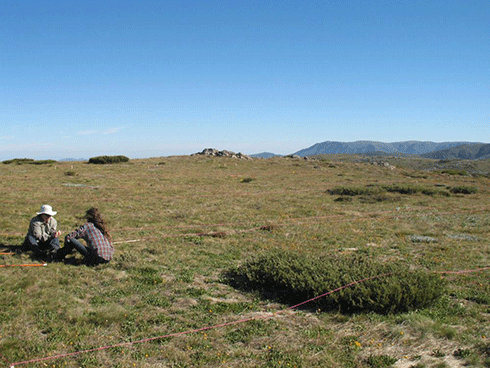
|
Published: 25 February 2014
Fertilisation and ‘nitrogen rain’ destabilise grassland ecosystems globally
Collaborative research across five continents shows that fertilisation drives the same damaging patterns seen in different grassland ecosystems across the planet.

|
|
A site in Victoria’s alpine region – one of 41 sites studied globally. Credit:
Yvonne Buckley
|
Natural grasslands make up a major portion of the world’s landmass. They are commercially important because they provide grazing for livestock and also provide vital refuges for a suite of endangered species.
Fertilisers are used in grasslands to increase livestock fodder, but fertilisation also occurs unintentionally when nitrogen, a common fertiliser, enters the atmosphere via farming, industry, and burning fossil fuels.
When rainfall brings nitrogen out of the atmosphere, and on to grasslands, it changes the growth and types of plant species present, which can have potentially dire consequences for ecosystem function.
In the new research, just published in Nature, scientists assessed the effects of fertiliser placed on monitored plots in 41 sites that spanned five continents and included the US, China, Australia, South Africa, the UK and Canada.
Typically, more diverse ecosystems that support a higher variation of species are more stable with regard to the amount of ‘biomass’ they produce, which can be used as an energy source throughout the food chain. When one species or group of plants has a bad year for some reason, their relatively poor performance can be compensated for by the others.
But when fertiliser is added, that ‘ecological safety net’ disappears. This worrying pattern holds true from the Tanzanian Serengeti, known to many as the setting of the great wildebeest migration, to the cool, alpine ecosystems of China.
‘Fertiliser creates more variation in biomass production from year to year, and the species all tend to respond in the same way, rather than compensating for each other,’ said Professor Yvonne Buckley of Trinity College Dublin, one of 33 co-authors, that also included CSIRO’s Dr Suzanne Prober.
‘Grassland production is vitally important for several ecosystem services including livestock production and the storage of atmospheric carbon, so we need to understand how pastures and grasslands provide these services as well as what happens when grasslands are changed through fertiliser inputs or deposition from the atmosphere,’ added Professor Buckley.
This is the first time such a large experiment has been conducted using naturally occurring sites, and was only made possible due to the formation of the Nutrient Network, also known as ‘NutNet’.
The idea behind NutNet was to standardise the way that ecology research is conducted, which is an important consideration when extrapolating scientific findings and increasing confidence in their general applicability.
NutNet is a grass-roots campaign supported by scientists who volunteer their time and resources. There are now 75 sites around the world that are run by more than 100 scientists participating in the ongoing NutNet experiment.
Source: Trinity College Dublin



